Chapter: Electrical and electronics : Network Reduction and Network Theorems for DC And AC Circuits
Network Reduction and Network Theorems for DC And AC Circuits
NETWORK
REDUCTION AND NETWORK THEOREMS FOR DC ANDAC CIRCUITS
1. NETWORK REDUCTION
2. VOLTAGE AND CURRENT DIVISION
3. POTENTIAL DIVIDER
4. VOLTAGE SOURCE TO CURRENT SOURCE
TRANSFORMATION
5. CURRENT SOURCE TO VOLTAGE SOURCE
TRANSFORMATION
6. STAR DELTA CONVERSION
7. THEVENINS THEOREM
8. NORTON’S THEOREM
Network reduction: voltage and current division,
source transformation –star delta conversion. Thevenins and Novton &
Theorem –Superposition Theorem –Maximum power transfer theorem – Reciprocity
Theorem.
1 NETWORK REDUCTION:
2 VOLTAGE AND CURRENT
DIVISION:
3 POTENTIAL DIVIDER:
The voltage distribution for the circuit
shown in Figure
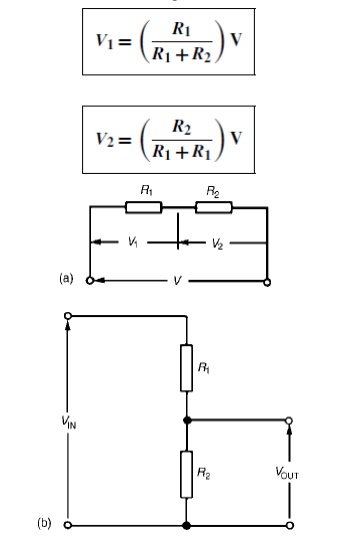
The circuit shown in Figure (b) is often
referred to as a potential divider circuit. Such a circuit can consist of a
number of similar elements in series connected across a voltage source,
voltages being taken from connections between the elements. Frequently the
divider consists of two resistors as shown in Figure (b), where

A potential divider is
the simplest way of producing a source of lower e.m.f. from a source of higher
e.m.f., and is the basic operating mechanism of the potentiometer, a measuring
device for accurately measuring potential differences
Problem 1: Determine
the value of voltage V shown in Figure
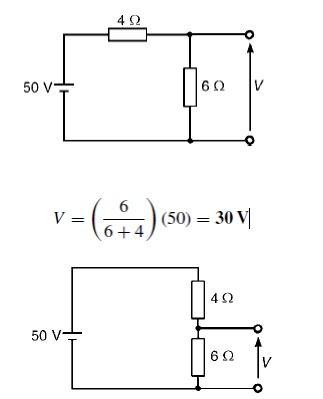
Problem 2: Two resistors are connected in series across a 24V supply and a current of 3A flows in the circuit. If one of the resistors has resis and (b) the p.d. across the 2 Ωresistor. If the circuit is connected for 50 hours, how much energy is used?
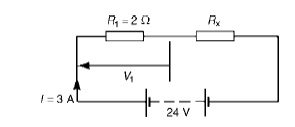
(a)
Total circuit resistance R= V/ I
= 24/3=8 Ω Value of unknown resistance,
Rx =8 −2=6 Ω
(b) P.d. across 2 Ωresistor, V1 =IR1
=3 × 2=6V Alternatively, from above,
V1 = (R1/R1 + Rx))
V = (2/2 + 6) (24) = 6V Energy used = power × time
= V
× I × t
= (24
× 3W) (50 h)
= 3600Wh
= 3.6kWh
Current division:
For the circuit shown in Figure, the total circuit
resistance, RT is given by:
RT = R1R2/R1
+ R2
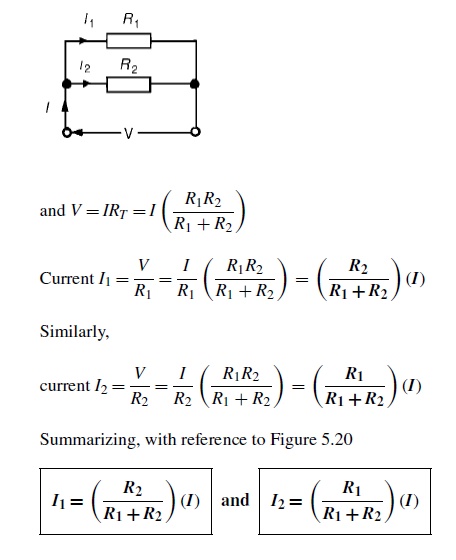
Problem 1: For
the series-parallel arrangement shown in Figure, find (a) the supply current,
(b) the current flowing through each resistor and (c) the p.d. across
each resistor.
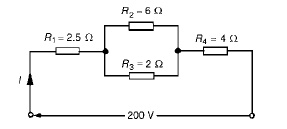
(a) The equivalent resistance Rx of R2 and R3 in
parallel is: Rx = 6 × 2/6 + 2
= 12/8
= 1.5
Ω
The equivalent resistance RT of R1,
Rx and R4 in series is:
RT = 2.5 + 1.5 + 4 = 8 Ω Supply current I
= V/RT
= 200/8
= 25A
The current flowing through R1 and R4
is 25A The current flowing through R2
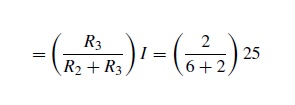
=
6.25A
The
current flowing through R3

=
18.75A
(c)
The equivalent circuit of Figure is
p.d. across R1, i.e. V1 =IR1 =(25)(2.5)=62.5V
p.d. across Rx, i.e. Vx =IRx =(25)(1.5)=37.5V p.d. across R4, i.e. V4
=IR4 =(25)(4)=100V
Hence the p.d. across R2 =p.d. across R3 =37.5V

Problem 2: For
the circuit shown in Figure 5.23 calculate (a) the value of resistor Rx such
that the total power dissipated in the circuit is 2.5kW, and (b) the
current flowing in each of the four resistors.
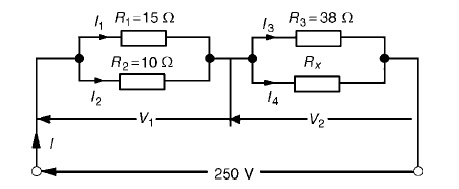
(a) Power dissipated P=VI watts, hence
2500=(250)(I) i.e. I = 2500/250
=
10A
From Ohm’sRT=V/I=law,250/10
=25 Ω, where RT is the equivalent circuit
resistance. The equivalent resistance of R1 and R2 in
parallel is =15 × 10/15 + 10
= 150/25
= 6
Ω
The equivalent resistance of resistors R3 and Rx in
parallel is equal to 25 Ω−6 Ω, i.e. 19 Ω. There are three methods whereby Rx
can be determined.
Problem 3: For
the arrangement shown in Figure find the current Ix.
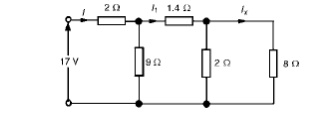
Commencing at the right-hand side of the
arrangement shown in Figure, the circuit is gradually reduced in stages as
shown in Figure
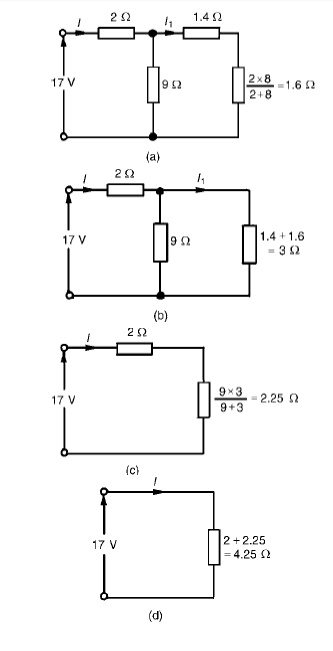
From Figure (d), I = 17/4.25 =4A
From Figure (b), I1
=9/9 + 3(I) = 12/ (4) =3A From Figure, Ix =2/2 + 8(I1) = 2/10(3) =0.6A
Source transformation:
Source transformation
is defined as to concert the sources for easy analysis of circuit. In mesh
analysis. it is easier if the circuit has voltage sources.
In nodal analysis. it is easier if the circuit has
current sources.
4. VOLTAGE SOURCE TO CURRENT SOURCE
TRANSFORMATION:
If voltage source is converted to current source,
then the current source I = V/Rse with
parallel resistance equal to Rse.
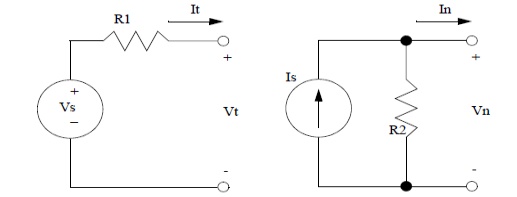
5. CURRENT SOURCE TO VOLTAGE SOURCE
TRANSFORMATION:
If current
source is converted to voltage source, then the voltage source I = V/ R sh with
series resistance equal to Rsh.
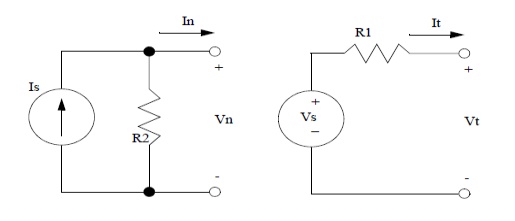
6. STAR DELTA CONVERSION:
In many circuit applications, we encounter
components connected together in one of two ways to
form a three-terminal network: the
―Delta or (also the ―Star (also known as the ―Y) configuration
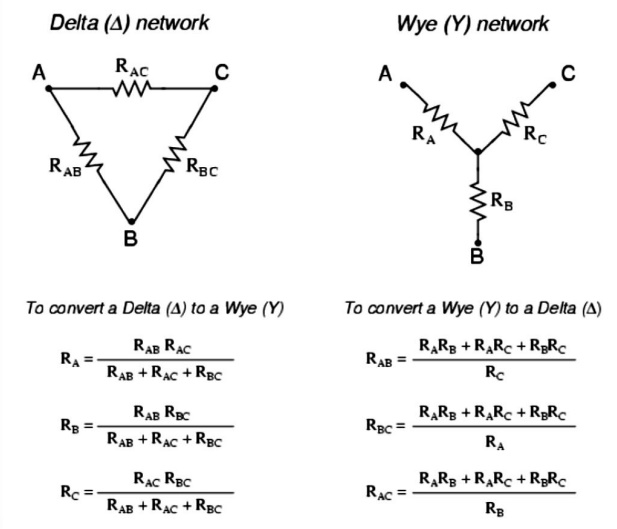
Problem 1: A
star-connected load consists of three identical coils each of resistance 30 Ω
and inductance 127.3 mH. If the line current is 5.08 A, calculate
the line voltage if the supply frequency is 50 Hz.
Inductive reactance XL =2πfL
=2π(50) (127.3×10−3) =40 Ω
Impedance of each phase
Zp =√(R2 + X2L) =√(302 +402) =50 Ω For a star connection IL =Ip =VpZp
Hence phase voltage Vp
=IpZp = (5.08)(50)=254V Line voltage VL =√3Vp =√3(254) =440V
Problem 2: A
415V, 3-phase, 4 wire, star-connected system supplies three resistive loads as
shown in Figure Determine (a) the current in each line and (b) the
current in the neutral conductor.
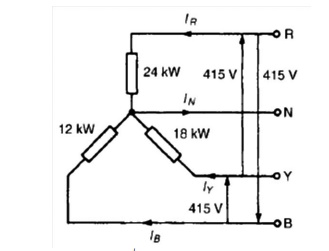
(a) For
a star-connected system VL =√3Vp

Since current I = Power
P/Voltage V for a resistive load then IR = PR/VR= 24 000/240=100A
IY = PY/VY= 18
000/240=75A and IB = PB/VB= 12 000/240=50A
(b) The three line
currents are shown in the phasor diagram of Figure Since each load is resistive
the currents are in phase with the phase voltages and are hence mutually displaced
by 120◦.The current in the neutral conductor is given by:
IN = IR + IY + IB phasorially.
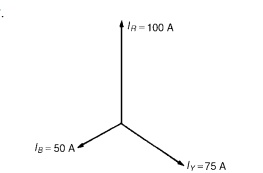
Figure shows the three
line currents added phasorially.Oa represents IR in magnitude and direction.
From the nose of Oa, ab is drawn representing IY in magnitude and direction.
From the nose of ab, bc is drawn representing IB in magnitude and direction. Oc
represents the resultant, IN.
By measurement, IN =43A
◦ ◦ ◦
Alternatively, by calculation, considering IR at 90
, IB at 210 and IY at 330 :
◦ ◦ ◦
Total horizontal component = 100 cos 90 + 75 cos 330
+50 cos 210 = 21.65
◦ ◦ ◦
Total vertical component = 100 sin 90 + 75 sin 330
+50 sin 210 = 37.50
Hence magnitude of IN =√(21.652 + 37.502)
=
43.3A
Problem 3: Convert
the given delta fig into equivalent star.
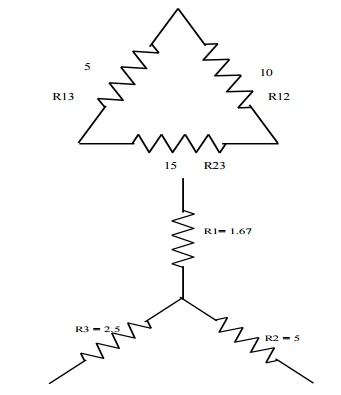
R1 = R12xR13/R12+R13+R23
R1 = 10x5/30 = 1.67Ω
R2 = 10 x 15/30 = 5Ω
R3 = 5 x 15/30 =
2.5Ω
Problem 4: Convert the given star in fig
into an equivalent delta.
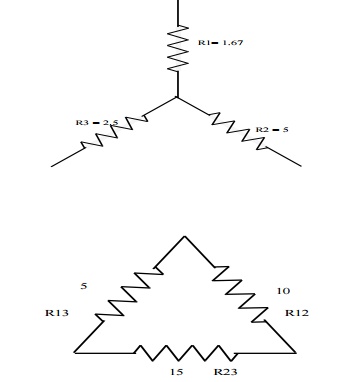
R12 = R1+R2 + R1R2/R3 = 1.67 x 5/2.5 +
1.67+5 = 10Ω
R23 = 2.5+5 2.5x5/1.67
= 15Ω
R31 = 2.5+1.67+ 2.5 x 1.67/5
= 5Ω
Problem 5: Obtain the delta connected
equivalent for the star connected circuit.

Problem 6: Obtain the star connected
equivalent for the delta connected circuit.
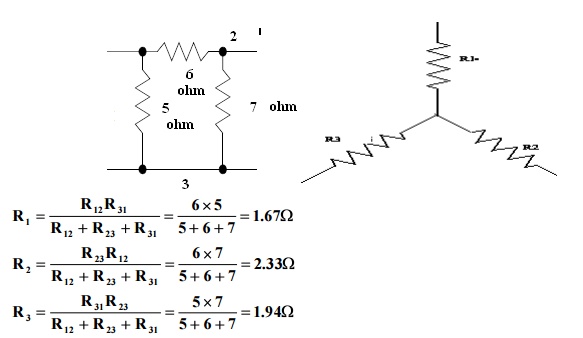
7. THEVENINS THEOREM:
In circuit theory, Thévenin's theorem
for linear electrical networks states that any combination of voltage sources,
current sources, and resistors with two terminals is electrically equivalent to
a single voltage source V and a single series resistor R. For single frequency
AC systems the theorem can also be applied to general impedances, not just
resistors.
The procedure adopted when using Théveni
determine the current in any branch of an active network (i.e. one containing a
source of e.m.f.):
(i) remove
the resistance R from that branch,
(ii) determine
the open-circuit voltage, E, across the break,
remove each source of e.m.f. and replace
them by their internal resistances and then determine the resistance, r,
‘looking-in’break.
(iv) determine the value of the current from the equivalent circuit shown in Figure 13.33, i.e. I = ER+r

Problem 1: Use Thévenin’s theorem to find the current flowing in the 10 Ω resistor for the circuit shown
in Figure
Following the above procedure:
The 10
Ωresistance is removed from the circuit as shown in Figure There is no current
flowing in the 5 Ωresistor and current I1 is given by:
I1 = 10/R1 +
R2
= 10/2 + 8
= 1A
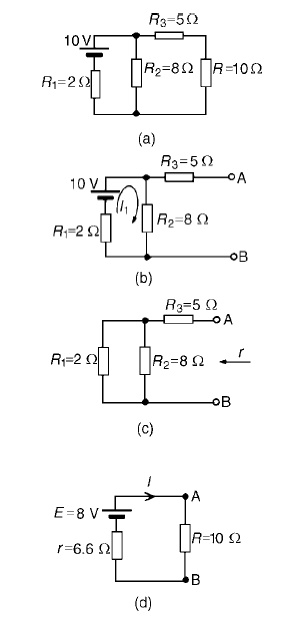
P.d. across R2 =I1R2
=1×8=8V Hence p.d. across AB, i.e. the open-circuit voltage across the break, E
=8V
(iii) Removing the
source of e.m.f. gives the circuit of Figure Resistance, r = R3 + R1R2/R1 + R2
=5+
(2×8/2+8)
=
5 + 1.6 = 6.6 Ω
(iv) The equivalent
Thévenin’s circuit is
shown in F
Current I = E/R+r= 8/10+6.6= 8/16.6=0.482A
Problem 2: For
the network shown in Figure determine the current in the 0.8 Ω resistor
using
Thévenin’s theorem.
Following the procedure:
The 0.8_ resistor is removed from the
circuit as shown in Figure
Current I1 = 12/1+5+4= 12/10
=1.2A
P.d. across 4 Ωresistor=4I1 =(4) (1.2)=4.8V
Hence p.d. across AB, i.e. the
open-circuit voltage across AB, E =4.8V
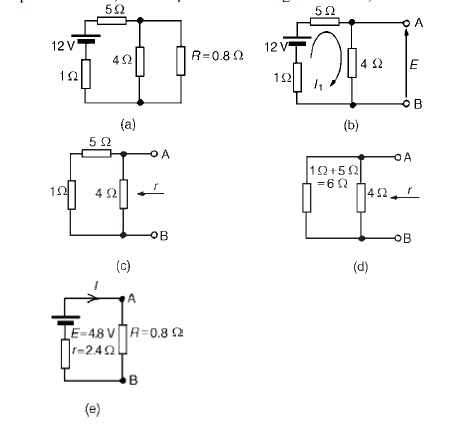
(iii) Removing the
source of e.m.f. gives the circuit shown in Figure (c). The equivalent circuit
of Figure
(c) is shown in Figure (d), from which,resistance r =
4×6/4+6= 24/10
=2.4
Ω
(iv)
The
equivalent Thévenin’s circuit I=E/+R is
show
= 4.8/2.4+0.8
= 4.8/3.2
I
= 1.5A=current in the 0.8 Ωresistor
Problem 3: U Use Thévenin’s theorem to determine the current I flowing in the 4 Ω resistor shown in Figure.
Find
also the power dissipated in the 4 Ωresistor.
(i) The 4 Ωresistor is removed from the circuit as
shown in Figure
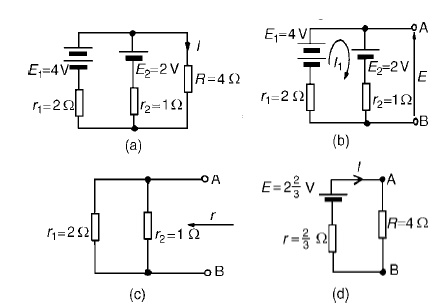
(ii) Current
I1 = E1 −E2/r1 +r2
= 4−2/2+1
= 2/3A

(iii) Removing the
sources of e.m.f. gives the circuit shown in Figure (c), from which resistance
r = 2 × 1/2 + 1 = 2/3 Ω
(iv)The
equivalent Thévenin’s circuit
is show

= 8/14
= 0.571A
= current
in the 4 Ωresistor
Problem 4: Power
dissipated in 4 Ωresistor,P=I2R=(0.571)2 (4)=1.304W Use
Thévenin’s t to determine the current flowing in the 3 Ω resistance of
the network shown in Figure (a). The
voltage source has negligible internal
resistance.
i) The 3 Ωresistance is
removed from the circuit as shown in Figure (b).
(ii) The
1 2/3 Ωresistance now carries no current. P.d. across 10
Ωresistor=(10/10+5)(24)
=16V
Hence p.d. across AB, E =16V
(iii) Removing the source of e.m.f. and replacing it by its internal resistance means that the 20 Ωresistance is short-circuited as shown in Figure (c) since its internal resistance is zero. The 20 Ωresistance may thus be removed as shown in Figure (d)
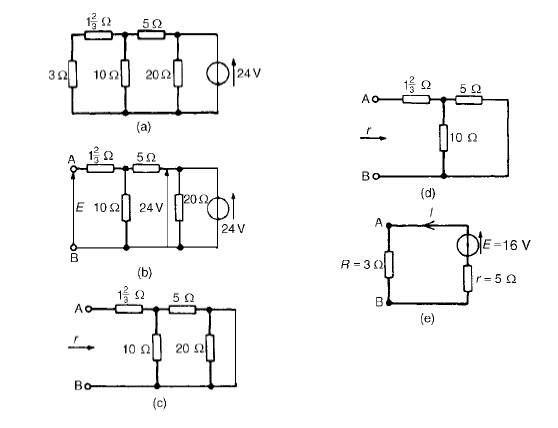
From Figure (d), resistance,
r =1 2/3+ 10×5/10+5 =5 Ω
(iv) The equivalent Thévenin’s circuit
is show current, I = E/r +R= 16/3+5= 16/8
=2A
Problem 5: AWheatstone
Bridge network is shown in Figure (a). Calculate the current flowing in the 32
Ωresistor, and its direction, using Théveni negligible resistance.
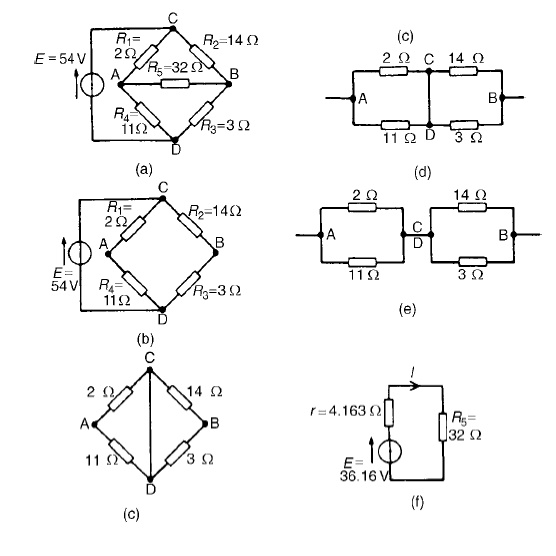
The 32 Ωresistor is removed from the circuit as
shown in Figure (b) The p.d. between A and C,
VAC =R1/R1 +R4 (E) =2/2+11(54) = 8.31V
The p.d. between B and C,
VBC =R2/R2 +R3 (E) =14/14+3(54) = 44.47V
Hence the p.d. between A and B=44.47−8.31=36.16V
Point C is at a potential of +54V. Between C and A
is a voltage drop of 8.31V. Hence the voltage at point A is 54−8.31=45.69V.
Between C and B is a voltage drop of 44.47V. Hence the voltage at point B is
54−44.47=9.53V. Since the voltage at A is greater than at B, current must flow
in the direction A to B.
Replacing the source of e.m.f. with a
short-circuit (i.e. zero internal resistance) gives the circuit shown in Figure
(c). The circuit is redrawn and simplified as shown in Figure (d) and (e), from
which the resistance between terminals A and B,
r = 2 × 11/2 + 11+ 14 × 3/14 + 3
= 22/13+
42/17
= 1.692
+ 2.471 = 4.163 Ω
(iv)
The
equivalent Thévenin’s circuit
is show
current
I = E/r +R5
= 36.16/4.163+32 =1A
8. NORTON’S THEOREM:
Norton’s theorem states
the following:
Any two-terminal linear bilateral dc
network can be replaced by an equivalent circuit consisting of a current and a
parallel resistor.
The steps leading to the proper values
of IN and RN. Preliminary steps:
1. Remove
that portion of the network across which the Norton equivalent circuit is
found.
2. Mark
the terminals of the remaining two-terminal network.
3. Finding
RN:
Calculate RN by first setting all
sources to zero and then finding the resultant resistance between the two
marked terminals. Since RN = RTh the procedure and value obtained using the approach described for Thevenin’s theorem will determine the proper value of RN.
4. Finding IN :
Calculate IN by first returning all the
sources to their original position and then finding the short-circuit current
between the marked terminals. It is the same current that would be measured by
an ammeter placed between the marked terminals.
5. Draw the Norton equivalent circuit
with the portion of the circuit previously removed replaced between the
terminals of the equivalent circuit.
Problem 1: Use
Norton’s theorem to determine Ω resistance for the the cur circuit
shown in Figure
The branch containing the 10 Ω
resistance is short circuited as shown in Figure
Figure (c) is equivalent to Figure
(b).Hence ISC = 10/2
=
5A
If the 10V source of e.m.f. is removed from Figure (b) the resistance ‘looking-in’ at a break made between A and B is given by:
r = 2 × 8/2 + 8
= 1.6 Ω
From the Norton
equivalent network shown in Figure(d) the current in the 10 Ωresistance, by
current division, is given by:
I = (1.6/1.6
+ 5 + 10) (5) = 0.482A
as obtained previously
in problem 7
using Thévenin’s theorem.
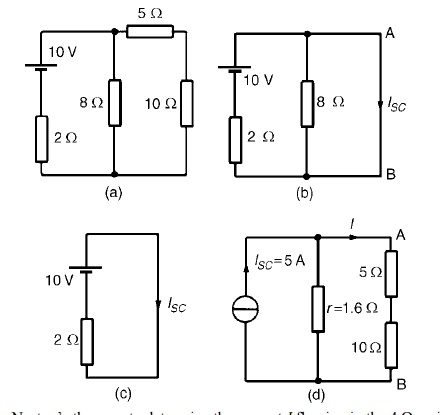
Problem 2: Problem 2: Use Norton’s theorem to determine the current I flowing in the 4 Ω resistance shown in Figure (a).

The 4 Ωbranch is short-circuited as shown in Figure
(b). From Figure (b), ISC =I1 +I2 =4A
If the sources of e.m.f. are removed the resistance
‘looking-in’at a break made be given by:
r = 2 × 1/2 + 1 =
2/3 Ω
From the Norton equivalent network shown in Figure
(c) the current in the 4 Ωresistance is given by:
I
=(2/3/(2/3)
+ 4)(4) = 0.571A,
as obtained previously in problems 2, 5 and 9 us
superposition and Thévenin.
Related Topics